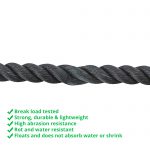0
Black Polypropylene (Add a Splice)
Follow the steps below to add a splice or knot to Polypropylene rope. Polypropylene is a versatile rope that is used for a range of everyday and commercial applications.
Please allow 5 working days for delivery
- Made in Europe (EN ISO 1346 – 2004)
- Break load certified
- From 39p per meter
No products were found matching your selection.
Polypropylene Rope Technical Details
Diameter / Weight / Break load
| Diameter | Weight per 220m (kg) |
Break load (kg)* |
| 4mm | 1.5 | 284 |
| 6mm | 3.7 | 600 |
| 8mm | 6.6 | 1,060 |
| 10mm | 10 | 1,560 |
| 12mm | 14.5 | 2,210 |
| 14mm | 20 | 3,050 |
| 16mm | 25.5 | 3,770 |
| 18mm | 32.5 | 4,810 |
| 20mm | 40 | 5,800 |
| 22mm | 48.5 | 6,950 |
| 24mm | 57 | 8,120 |
| 28mm | 78 | 10,700 |
| 32mm | 101 | 13,460 |
| 36mm | 129 | 16,920 |
| 40mm | 158 | 20,490 |
*Break load for indication purposes only. Break loads will lower as a result of splicing and knotting.
Resistance
| Resistance | Description |
| UV resistance | Moderate |
| Abrasion resistance | Good |
| Rot and mould | Yes |
| Chemical | Good resistance to most acids, alkalis. |
Properties
| Properties | Description |
| Construction | Twisted 3-strand yarn construction |
| Material | Synthetic |
| Quality certified | ISO 9002 |
| Appearance | Black. Smooth, shiny, synthetic appearance |
| Feel | Hard, smooth, slippy surface |
| Handling | Very lightweight. Flexible. Can also be softened |
| Density | 0.91 |
| Strength (dry) | Strong, tough, durable all-round rope. Not as strong as Nylon or Polysteel |
| Strength (wet) | Same as when dry. No loss of strength |
| Shock absorbency | Good |
| Elongation at break load | Moderate |
| Stretch (elasticity) | Low |
| Performance in water | Floats. Does not absorb water. Does not weaken or shrink when wet |
| Melting point | 170°C |
| Electrical conductivity | Poor |
| Biodegradable | No |
| Storage | Wet or dry environments |
| Knot retention | Low |
| Can be spliced? | Yes – easily |
| Can be cut? | Yes but ends will unravel. Recommend melting ends with flame to seal them |
| Can be dyed? | No |
| Can be softened? | Yes – a popular method uses water and fabric softener |




